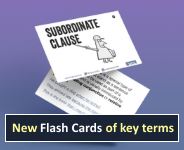Indirect Object
Consider the following example. Here we have two noun phrases which follow the Predicator (the verb).
- I’ll give [you] [the school’s number]. [W2F-020 #192]
Can you see how they build up the meaning of the clause? Both noun phrases refer to participants in the situation of ‘giving’, but the participants have different roles.
The school’s number identifies what is given. This is the Direct Object – the Direct Object identifies who or what is being 'verbed' (in active clauses).
You identifies the recipient of the school’s number (the one who receives it). This element is called the Indirect Object. It occurs in a pattern with two Objects, in the order:
- Indirect Object + Direct Object.
Here are some more examples of Indirect Objects:
- We got you a blue bunny costume. [S1B-079 #122]
- You sent me a copy of the tax return for the year ending 5 April. [W1B-022 #48]
- I cooked Rosie dinner. [S1A-048 #266]
The basic clause pattern is:
| Subject | Predicator | Indirect Object | Direct Object |
|
got | you | a blue bunny costume |
|
sent | me | a copy of the tax return for the year ending 5 April 1991 |
|
cooked | Rosie | dinner |
In each example, the Indirect Object refers to a participant with the role of ‘recipient’.
- ‘You’ is/are the future recipient of a blue bunny costume.
- A copy of the tax return was received by ‘me’.
- Rosie is the intended recipient of the dinner I cooked.
The Indirect Object is a grammatical function. Although the Indirect Object often refers to a recipient, they are not the same thing.
The ‘recipient’ is what we would call a semantic role. It is a way of talking about how, in the real world, the participants of the sentence interact.
Compare these examples, which belong to the same clause pattern as before:
- Easterly winds bring us this extreme cold. [W2B-026 #52]
We can also employ different clause patterns with the same recipient roles.
Compare:
|
[Indirect Object + Direct Object] |
|
[Direct Object + Adverbial] |
In both examples the recipient is ‘you’, but the grammatical functions are different.
- In the first example we have the noun phrase you functioning as Indirect Object.
- In the second example we have the preposition phrase to you functioning as an Adverbial.
If you can convert one pattern into the other you can apply this to your own compositions.
See if you can think of alternative clause patterns for the other examples:
| First pattern | Alternative pattern |
| Indirect Object + Direct Object | Direct Object + Adverbial |
|
~We got [a blue bunny costume] [for you]. |
|
~You sent [a copy of the tax return for the year ending 5 April] [to me]. |
|
~I cooked [dinner] [for Rosie]. |
Like the Direct Object, the Indirect Object can often become the Subject of a passive clause. Compare:
- Active: I’ll give you the school’s number. [you = Indirect Object]
- Passive: You’ll be given the school’s number (by me). [you = Subject]
Can you complete the following passive?
- Active: You sent me a copy of the tax return for the year ending 5 April. [you = Indirect Object]
- Passive: I ...
- Passive: I was sent a copy of the tax return for the year ending 5 April (by you).
Notice the change from me to I here. The Indirect Object, like the Direct Object, takes the accusative case when it is a pronoun with different case forms (while the Subject takes nominative case).
Key points
The Indirect Object:
- usually takes the form of a noun phrase
- usually comes after the Predicator and before the Direct Object
- often refers to a ‘recipient’ of the verb
- can often become the Subject of a passive construction
- takes objective case (if it is a pronoun with different case forms)
A clause can also function as Direct Object, as we can see by comparing these examples:
- James Baker, the secretary of state, told Congress the same thing. [W2E-010 #27]
- She told them that she would buy a new table. [W2F-020 #119]
Both examples involve the verb told in the pattern with Indirect Object + Direct Object. In the first example we have a noun phrase as Direct Object (the same thing). In the second we have a clause as Direct Object (that she would buy a new table).
Here are some more examples with an Indirect Object and a clause as Direct Object. See if you can identify the two Objects:
- She promised me she would ring. [S1A-040 #413]
- She promised [me] [she would ring].
- I always tell people I am not a musical person. [S1B-046 #26]
- I always tell [people] [I am not a musical person].
- Oh actually Dad asked me if Sarah had phoned me on Sunday. [S1A-023 #122]
- Oh actually Dad asked [me] [if Sarah had phoned me on Sunday].
Note that 'Indirect Object' is not a statutory term in the National Curriculum, i.e. it does not have to be taught at KS1 and KS2.
Welcome!

Englicious is totally free for everyone to use!
But in exchange, we ask that you register for an account on our site.
If you’ve already registered, you can log in straight away.
Since this is your first visit today, you can see this page by clicking the button below.

